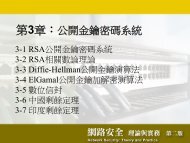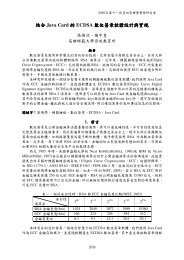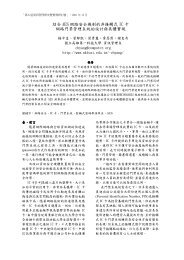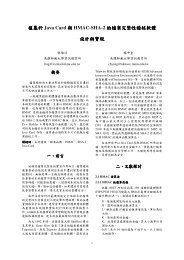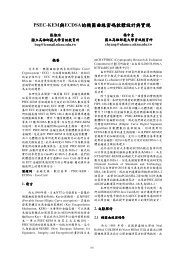aryabhata remainder theorem: relevance to public-key crypto ...
aryabhata remainder theorem: relevance to public-key crypto ...
aryabhata remainder theorem: relevance to public-key crypto ...
You also want an ePaper? Increase the reach of your titles
YUMPU automatically turns print PDFs into web optimized ePapers that Google loves.
8 RAO AND YANG<br />
3.2. Multiplicative inverse algorithm<br />
The EEA can be improved <strong>to</strong> perform better if only one inverse is required. For<br />
instance, if a −1 mod b is required for a > b, we may just as well begin with<br />
a mod b = c and find c −1 mod b. In that case, the xi computation will be one less<br />
step. Further, if the initial values are set appropriately, the inverse can be obtained<br />
in n − 2 forward steps (each step: one multiplication and one addition), the same<br />
number of steps as in the IAA (Section 1.2). We illustrate this by using the same<br />
example as before with another table.<br />
Example 5. Find 137 −1 mod 60 (a = 137 and b = 60)<br />
We start with r0 = b = 60, r1 = a mod 60 = 17, and x1 = 1. The iterations<br />
begin from i = 2 with the normal division process: qi ← quotient(ri−2/ri−1),<br />
ri ← ri−2 mod ri−1, and x2 = q2.<br />
The iteration proceeds: xi ← xi−1 · qi + xi−2 (for i > 2).<br />
i ri qi xi<br />
0 60 – –<br />
1 17 – 1<br />
2 9 3 3<br />
3 8 1 4<br />
4 1 1 7<br />
5 0<br />
From this we observe the following:<br />
a · xi(−1) i−1 mod b = ri for i ≥ 1, 137 · 7(−1) 4−1 mod 60 = 1,<br />
X = 137 −1 mod 60 = 60 − 7 = 53.<br />
We can now state the following lemma.<br />
Lemma 3. Let a, b, ri, qi, and xi be defined as above. Then a −1 mod b exists iff<br />
xn = 1 (for some n > 1) and is given by<br />
a −1 mod b = xn(−1) n−1 .<br />
Proof. First, we need <strong>to</strong> prove that a · xi(−1) i−1 mod b = ri holds for i ≥ 1.<br />
For i = 1, we have x1 = 1 and a · x1(−1) i−1 mod b = r1. Fori = 2, we have<br />
the division equation r2 = r0 − q2 · r1 = r0 − x2 · r1. Taking mod b on both<br />
sides, we get (−x2) · r1 mod b = r2, which is the same as (−x2)a mod b = r2.<br />
For i = 3, we start with r3 = r1 − q3 · r2 = r1 · x1 − q3(r0 − x2 · r1) =<br />
r1(x2 · q3 + x1) − q3 · r0 = r1 · x3 − q3 · r0. Taking mod b on both sides, we<br />
have r1 · x3 mod b = r3 and a · x3 mod b = r3. Continuing this process, we obtain<br />
a · xn(−1) n−1 mod b = rn = 1 and a −1 mod b = xn(−1) n−1 . ✷





